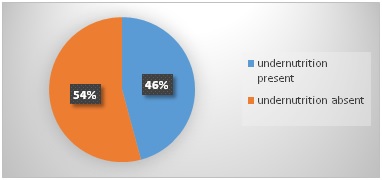Prevalence of under nutrition and associated factors among female higher secondary students in the schools of costal block panchayat in Kerala
Abstract
Introduction: The health status of an adolescent determines the health status in her adulthood. Adolescent girls in the age group 15-19 years are closer to their mother hood and thus the low birth weight girls become the next generation of stunted mothers thus, perpetuating the vicious cycle of malnutrition.
Objectives: 1) To determine the prevalence of under nutrition among female higher secondary students in the schools of Ambalapuzha block. 2) To determine the factors associated with under nutrition.
Methods: Cross- sectional study was conducted among higher secondary female students in the schools of Ambalapuzha Block. Sample size was calculated using the formula Zα2PQ/L2 (Zα -1.96, P -33, Q -67 L -12% of P). Considering design effect (1.5) and 10% non-response, 559 adolescents were studied. Stratified and cluster sampling method was used. Information was collected using semi structured questionnaire. Weights and heights were measured and body mass index calculated and compared with Tim Cole anthropometric standards.
Results: Prevalence of under nutrition was found to be 45.8%. Factors associated with undernutrition were Hindu religion, nuclear family, father manual laborer or fisher man and absence of media influence on nutrition. Father being a manual laborer or fisherman was found to be an independent predictor of under nutrition.
Conclusion: Prevalence of under nutrition was found to be high among female higher secondary students in Ambalappuzha Block
Downloads
References
2. Adolescent Health Division, Ministry of Health and Family Welfare, Government of India. India_ RKSK_StrategyOperational_Framework-translating strategy into programmes [Internet]. 2014
3. Govt of India, Planning Commission. Empowerment of women and development of children [Internet]. 2001 [cited 2017 Jul 29]. Available from http://planning-commission.nic.in/aboutus/ committee/ strgrp /stgp_ woman.pdf
4. Behrman J, Alderman H, Hoddinott J. Hunger and malnutrition. Glob Crises Glob Solut. 2004;363–420.
5. Hélène Delisle, V chandramouli et al. Should Adolescents Be Specifically Targeted for Nutrition in Developing Countries? To Address Which Problems, and How? 2005 [cited 2017 Aug 3]
6. WHO Regional Office for the South-East Asia Region. Health Situation in the South-East Asia Region: 2001-2007. [Internet]. Geneva; Herndon: World Health Organization Stylus Publishing, LLC [distributor; 2009 [cited 2017 Nov 10]. Available from: http://site.ebrary. com/id/10338568
7. Ambalappuzha Block Panchayat, official website [Internet]. [cited 2017 Oct 19]. Available from: http://lsgkerala.in/ambalapuzhablock/general-information/
8. Parasuraman S, Kishor S, Singh SK, Vaidehi Y. A profile of youth in India. National Family Health Survey (NFHS-3), India, 2005-06. Mumbai: International Institute for Population Sciences; Calverton, Maryland, USA: ICF Macro; 2009 [Internet]. [cited 2017 Mar 18]. Available from: http://www. dhsprogram.com/pubs/pdf/OD59/OD59.pdf
9. Ministry of Women and Child Development, Government of India. Rapid survey on Children 2013-2014 [Internet]. [cited 2017 Jul 25]. Available from: http://wcd.nic.in/sites/default/files/State%20RSOC.pdf
10. P. NB, L. M, Bindhu A. A study of adolescent health problems in a rural school in Thiruvanthapuram district, Kerala, India. Int J Community Med Public Health. 2016 Dec 21;4(1):100.
11. International Institute for Population Sciences, Deonar, Mumbai. National Family Health Survey (NFHS-3) India-2005-2006, Kerala [Internet]. 2008 [cited 2017 Aug 9]. Available from: http://rchiips.org/ nfhs/ NFHS-3% 20 Data/ke_state_ report _for_ website.pdf
12. Kumar A. Nutritional status of adolescent girls in rural Tamilnadu. Religion. 2012;102:42.
13. Pal A, Pari AK, Sinha A, et al. Prevalence of undernutrition and associated factors: A cross-sectional study among rural adolescents in West Bengal, India. Int J PediatrAdolesc Med. 2017 Mar;4(1):9-18. doi: 10.1016/j.ijpam.2016.08.009. Epub 2016 Sep 13.
14. Venkaiah K, Damayanti K, Nayak MU, et al. Diet and nutritional status of rural adolescents in India. Eur J Clin Nutr. 2002 Nov;56(11):1119-25. DOI:10.1038/sj. ejcn.1601457
15. Goldani MZ, Haeffner LS, Agranonik M, et al. Do early life factors influence body mass index in adolescents? Braz J Med Biol Res. 2007 Sep;40 (9): 1231-6. Epub 2007 Sep 10.
16. Gillespie S, Mason J. Malnutrition and Infection − A review − Nutrition policy discussion paper No. 5. U N-Adm Comm Coord-SubcommNutr ACCSCN. 1989 Oct;5.
17. Laurberg P, Knudsen N, Andersen S, et al. Thyroid function and obesity. Eur Thyroid J. 2012 Oct;1(3):159-67. doi: 10.1159/000342994. Epub 2012 Sep 22.
18. Velayutham K, Selvan SS, Unnikrishnan AG. Prevalence of thyroid dysfunction among young females in a South Indian population. Indian J Endocrinol Metab. 2015 Nov-Dec;19(6):781-4. doi: 10. 4103/2230-8210.167546.
19. R.Priyadarshini, Jasmine S Sundar, Valarmathi. S, Kalpana. S, ParameswariSrijayanth. Impact of media on the physical health of urban school children of age group 11-17yrs in Chennai - A cross sectional study. IOSR J Humanit Soc Sci. Volume 9, Issue 5 (Mar.-Apr. 2013):30–5.
20. Banna JC, Buchthal OV, Delormier T, Creed-Kanashiro HM, Penny ME. Influences on eating: a qualitative study of adolescents in a periurban area in Lima, Peru. BMC Public Health [Internet]. 2016 Jan 15;16. Available from: http://www.ncbi.nlm. nih.gov/ pmc/articles/PMC4714484/
21. Harris JL, Bargh JA. Television viewing and unhealthy diet: implications for children and media interventions. Health Commun. 2009 Oct;24(7):660-73. doi: 10.1080/10410230903242267.
22. Bickham DS, Blood EA, Walls CE, et al. Characteristics of screen media use associated with higher BMI in young adolescents. Pediatrics. 2013 May; 131(5): 935-41. doi: 10.1542/ peds. 2012-1197. Epub 2013 Apr 8.
23. Peixoto Mdo R, Benício MH, Jardim PC. The relationship between body mass index and lifestyle in a Brazilian adult population: a cross-sectional survey. Cad Saude Publica. 2007 Nov;23(11):2694-740.

Copyright (c) 2019 Author (s). Published by Siddharth Health Research and Social Welfare Society

This work is licensed under a Creative Commons Attribution 4.0 International License.


 OAI - Open Archives Initiative
OAI - Open Archives Initiative


